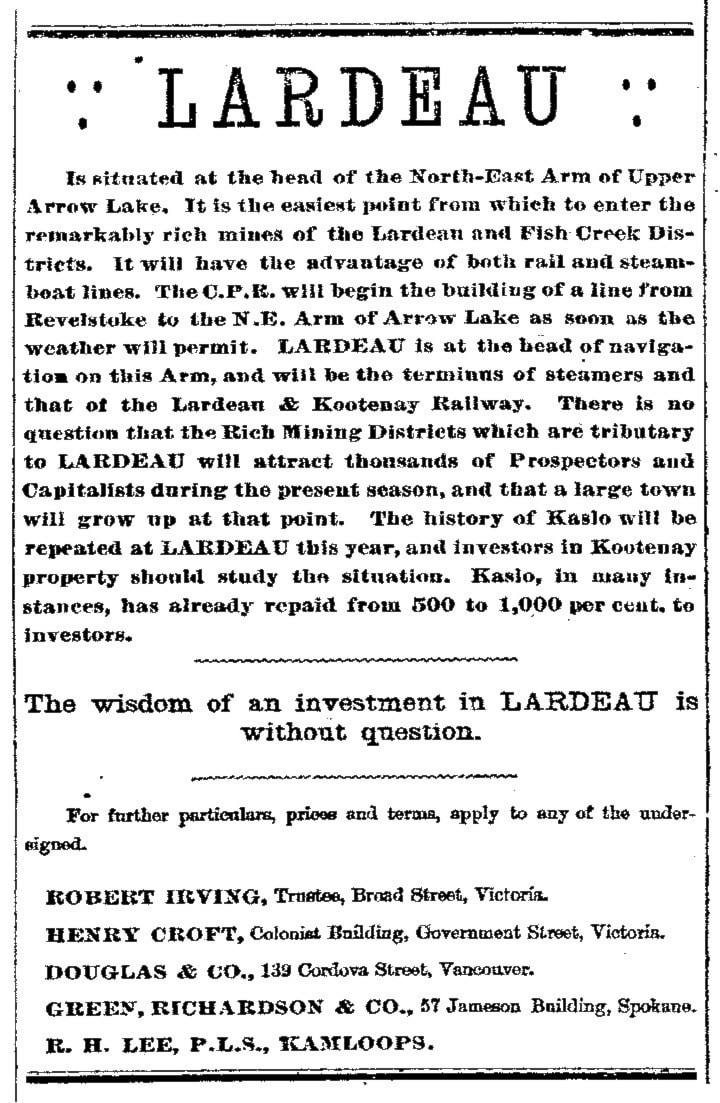One-hundred fourteenth in a semi-alphabetical series on West Kootenay/Boundary place names
Last week we looked at the little-known battle between Lardo (on Kootenay Lake) and Lardeau (on the northeast arm of Upper Arrow Lake) over the right to use the name.
The towns’ intransigence meant that by 1895, neither received the post office they desired. However, that year MP John Mara wrote the postmaster general, requesting an office be opened at Lardeau. The department asked BC postal inspector E.H. Fletcher to look into it, but he replied: “I am informed that the townsite has not been built upon to any extent within the past year, nor has the the population increased. In fact I am given to understand that there are no more than half a dozen people living there.”
There is some indication it was nevertheless approved, for the Kootenay Mail of May 2, 1896 reported: “Lardeau City has at last been made a post office to commence business May 1st. C. Menhenick, postmaster.” However, it didn’t open and Lardeau soon ceased to exist. Its buildings were moved to the new nearby town of Comaplix (some sources mistakenly state they were actually the same place).
While promoters of the Lardeau townsite insisted on that name, others in the area weren’t so enamoured with it. The Revelstoke Herald of April 3, 1897 reported: “The people of Thomson's Landing are thinking of petitioning the government to change the name of this mining district from Lardeau to one more appropriate. This is not Lardeau mining district except on a government map. It is Fish Creek and Upper Arrow Lake district and never can be anything else.”
The paper accused the townsite owners of causing confusion by “stealing a name from a neighbouring district” and declared “we don't require the services of a borrowed name to bring the district to the front … We don't want the name Lardeau for this district. It is all right where it belongs, but it has always been a hoodoo to those who stole it from its rightful owners.”
Lardeau, they said, was the country around the north and south forks of the upper and lower Lardeau River and Trout Lake.
“Call this district Fish Creek, Arrowhead, Comaplix, or Barnato,” the paper said. “Anything but Lardeau for that it can never be.”
In 1899, a post office finally opened at Lardo. It changed its name to Lardeau in 1947 and closed in 1967 with the establishment of the Meadow Creek post office.
Coincidentally, there was a Lardo on Payette Lake in central Idaho. A post office operated there from 1889 to 1917. The origin of its name is hazy, although Frank P. Rowland related this story in his 1960 book Founding of McCall, Idaho:
“A huge painting in the Shore Lodge dining room shows a team of horses running away with a wagon load of freight consisting of sacks of flour and buckets of lard in boxes. The boxes have broken open and the lids have been knocked off the cans. The flour sacks have burst, the flour mixing with the lard making a dough — lard and dough — Lard, Oh! Lardo.”
Rowland said he tried hard to prove or disprove the story. He was initially skeptical, noting it wasn’t told until many years after the fact, but eventually came to believe it was true.
Today Lardo is considered the western part of the town of McCall.
Previous installments in this series
Applegrove, Appleby, and Appledale revisited
Bakers, Birds, and Bosun Landing
Bannock City, Basin City, and Bear Lake City
Bealby Point (aka Florence Park) revisited
Boswell, Bosworth, Boulder Mill, and Broadwater
Brooklyn, Brouse, and Burnt Flat
Camborne, Cariboo City, and Carrolls Landing
Carmi, Cedar Point, Circle City, and Clark’s Camp
Carson, Carstens, and Cascade City
Christina City and Christian Valley
Cody and Champion Creek revisited
Champion Creek revisited, again
Columbia City, Columbia Gardens, and Columbia Park
Crawford Bay and Comaplix revisited
Dawson, Deadwood, and Deanshaven
English Cove and English Point
Forslund, Fosthall, and Fairview
Fort Shepherd vs. Fort Sheppard, Part 1
Fort Shepherd vs. Fort Sheppard, Part 2
Gladstone and Gerrard, revisited
Granite Siding and Granite City
Hall Siding and Healy’s Landing
Hudu Valley, Huntingtdon, and Healy’s Landing revisited
Inonoaklin Valley (aka Fire Valley)
Jersey, Johnsons Landing, and Jubilee Point
Kootenay Bay, Kraft, and Krestova
Kuskonook (and Kuskanax), Part 3
